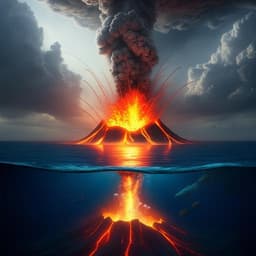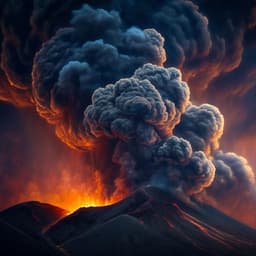
Earth Sciences
Perturbations in stratospheric aerosol evolution due to the water-rich plume of the 2022 Hunga-Tonga eruption
Y. Zhu, C. G. Bardeen, et al.
Discover the groundbreaking findings of researchers Yunqian Zhu and colleagues as they reveal how the January 2022 Hunga Tonga-Hunga Ha'apai volcanic eruption significantly altered stratospheric conditions by injecting unprecedented amounts of water, ultimately impacting climate systems until October 2022.
~3 min • Beginner • English
Introduction
In mid-January 2022, the submarine Hunga Tonga–Hunga Ha'apai (HTHH) eruption lofted material to ~58 km, producing unusual stratospheric enhancements of SO2, H2O, aerosols, and possibly ice observed by multiple satellites (TROPOMI, OMPS-NM/LP, MLS, CALIOP). Unlike typical land eruptions, HTHH injected an exceptionally large amount of water (>100 Tg) into a stratosphere that normally contains ~1500 Tg globally. Rapid post-eruption observations showed abundant sulfate aerosol surprisingly early, despite SO2 generally requiring time to oxidize to H2SO4 and nucleate. The study tests the hypothesis that the extraordinary stratospheric H2O from HTHH accelerated sulfate formation by increasing OH, thereby shortening SO2 lifetime, enhancing coagulation to larger particles, and increasing aerosol optical depth. It further investigates how the water- and sulfate-rich plume evolves, affects radiative forcing, and potentially influences polar chemistry through transport toward and persistence near the Antarctic polar vortex.
Literature Review
Methodology
The study used CESM2 with WACCM (70 levels to 140 km; ~1–1.5 km vertical resolution in the stratosphere), fully coupled to interactive ocean, sea ice, and land. Ocean and sea-ice were initialized on Jan 3 using JRA55-do forced ocean output; land from a standalone model forced by NCEP CFSv2; atmosphere from a transient WACCM run. The atmospheric model was nudged to GEOS5 analyses (3-hourly fields, 12-h relaxation) from Jan 3–Mar 30, 2022; after Apr 1, three ensemble members (nudging end dates Mar 29–31) were run freely to October. Ensembles: (1) Control (no injections), (2) SO2only, (3) SO2_H2O; plus a sensitivity H2Oonly case for radiative impacts. Injection specifications on Jan 15, 2022 04–10 UTC over ~6×10^5 km^2 (22°S–14°S, 182°E–186°E): SO2 total 0.42 Tg (0.3 Tg from 20–22 km; 0.12 Tg from 22–28 km, uniform number density); H2O total 150 Tg (103 Tg from 25.5–27 km; 42 Tg from 27–30 km; 5 Tg from 30–35 km, uniform concentration). Ice microphysics allowed homogeneous and heterogeneous nucleation in the stratosphere for T < −40 °C. Ash injection was not included due to lack of evidence for persistent ash (low UV AI; CALIOP depolarization and LOAC observations indicated mainly spherical submicron sulfate). Observational datasets: MLS v4 (quality screened; water vapor), OMPS-LP v2.0 aerosol extinction at 997 nm (center slit), CALIPSO, SAGE III/ISS, and SO2 mass from OMPS-NM and TROPOMI. For SO2 comparisons, modeled grid boxes with SO2 < 0.2 DU were excluded to mimic OMPS detection limits (~0.1 DU noise; 0.2 DU threshold), with reported observational uncertainties ~35% (OMPS-NM) and ~30% (TROPOMI). Sensitivity tests explored varying SO2 amounts (0.84 Tg) and wider injection bands (20° latitude) and were evaluated against OMPS-LP aerosol properties. Radiative effects were computed as differences relative to control at the top of atmosphere and surface. Transport forecasts were analyzed for column H2O, condensed sulfur mass, and aerosol surface area density (SAD), including significance via Student’s t-test (90% level) after April 1 across ensemble members.
Key Findings
- MLS and model both show a persistent positive stratospheric H2O anomaly of ~6–8 ppmv peaking near 30 hPa from February to April 2022, slowly ascending consistent with Brewer–Dobson circulation.
- To match MLS anomalies, simulations required ~150 Tg H2O injected over ~6×10^5 km^2; in-model evolution indicates ~10 Tg ice fallout, ~10 Tg ice evaporated, leaving ~140 Tg residual H2O through April.
- The large H2O injection rapidly increased OH, shortening SO2 lifetime: e-folding time decreased from 28 days (SO2only) to 12 days (SO2_H2O). Accounting for instrument detection limits had minimal effect on the first 10 days for this event.
- Enhanced oxidation led to much earlier sulfate formation; coagulation produced larger particles. sAOD approximately doubled in February in the SO2_H2O case compared to SO2only. Backscatter coefficients (visible) reached ~0.005–0.01 km⁻1 sr⁻1, consistent with CALIOP.
- Radiative impacts: localized TOA cooling of ~−1 to −2 W m⁻2 over perturbed regions in Jan–Feb. Global mean TOA forcing in February was −0.13 W m⁻2 (SO2only) vs −0.21 W m⁻2 (SO2_H2O); surface radiative effect −0.16 vs −0.21 W m⁻2. Water-only forcing was positive in the Southern Hemisphere but much smaller than aerosol forcing.
- Transport forecasts: volcanic H2O and condensed-phase sulfur moved poleward, largely residing between 30°S–60°S after mid-June due to the Antarctic vortex barrier. Despite most material staying outside the vortex, condensed sulfur at 90°S increased by ~10% from April and nearly doubled by October.
- By late September near the vortex edge, H2O increased by ~2–3 ppmv (50–10 hPa) and aerosol SAD increased by ~2–4.5 μm² cm⁻3 (150–30 hPa); inside the vortex at 100 hPa, SAD increased by ~1.5 μm² cm⁻3. Differences in altitude reflect aerosol sedimentation.
- Heterogeneous chemistry sensitivity: increasing H2O by ~3 ppmv raises the HCl + ClONO2 reaction probability by about one order of magnitude above ~194 K (for 0.1 μm particles), implying potential enhancement of active chlorine and impacts on ozone chemistry.
- Overall, the water-rich eruption is projected to enhance aerosol surface area and water vapor near the Southern Hemisphere polar vortex at least through October 2022, with implications for radiative forcing and ozone processes.
Discussion
The findings confirm the central hypothesis that an anomalously water-rich volcanic injection can strongly perturb stratospheric aerosol evolution. Elevated H2O boosted OH, halving SO2 lifetime and accelerating sulfate nucleation and growth, yielding larger particles and a near-doubling of sAOD compared to a water-free case. Despite larger aerosol burdens, the increase in negative radiative forcing at the global scale was modest because added stratospheric H2O imparted a small positive longwave forcing that partially offset aerosol cooling. The forecasted transport shows persistent enhancements of H2O and aerosol SAD near the Antarctic vortex into spring 2022. These microphysical and transport changes elevate the likelihood of enhanced heterogeneous chemistry (e.g., HCl + ClONO2) and altered HOx/NOx cycles, with potential consequences for polar ozone depletion, especially given increased SAD and sensitivity of PSC processes to H2O. The study underscores the role of stratospheric water in modulating volcanic aerosol evolution, radiative forcing, and chemical impacts, and demonstrates the utility of a constrained Earth system model to interpret satellite observations and project near-term evolution.
Conclusion
This work demonstrates that the exceptional stratospheric water injection from the January 2022 HTHH eruption substantially altered aerosol microphysics and radiative effects: OH increases halved SO2 lifetime, sulfate formed earlier and coagulated to larger sizes, and sAOD doubled relative to a water-free scenario. The resulting radiative forcing was regionally strong (−1 to −2 W m⁻2) but globally modest (≈−0.2 W m⁻2 in February when including H2O). Simulations project that enhanced H2O and aerosol SAD persisted near the Antarctic vortex through at least October 2022, implying continued influence on the climate system and potential impacts on polar ozone chemistry. Future research should quantify the 2022 Antarctic ozone response to combined H2O and aerosol perturbations, refine representation of rapid plume dynamics (e.g., wind shear and cooling), assess longer-term climate feedbacks of stratospheric hydration events, and evaluate sensitivity to uncertain injection parameters and aerosol-ice-ash interactions.
Limitations
- Model resolution and specified dynamics limited the ability to reproduce early, rapid plume spreading and vertical wind shear; observed fast spreading and cooling inside the plume were underrepresented, affecting early transport and dispersion.
- OMPS-LP retrievals have larger uncertainties during the first days when the plume was optically thick and localized; comparisons during that period are less certain.
- Injection parameters (amounts, vertical distributions, and area) were tuned to match observations; the injected area was larger than observed anvil size to retain sufficient residual H2O, introducing uncertainty.
- Ash injection and SO2 uptake on ice were not included (supported by observations and literature), but any unaccounted ash-ice interactions could affect microphysics and chemistry.
- Instrument detection limits (e.g., OMPS SO2 < 0.2 DU) and observational uncertainties (≈30–35%) constrain precise SO2 burden estimates.
- Inside the Antarctic vortex, some modeled H2O anomalies after June did not pass a 90% significance t-test across ensemble members, indicating limited statistical confidence in certain regional signals.
- Nudged meteorology may not capture strong localized cooling within the plume, influencing early aerosol formation and spread.
Related Publications
Explore these studies to deepen your understanding of the subject.







